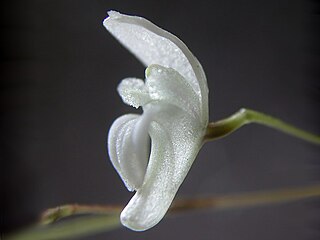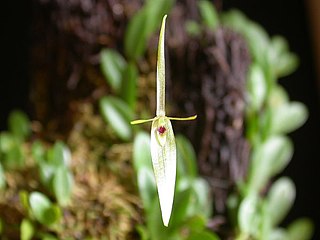
Stelis, or leach orchids, is a large genus of orchids, with perhaps 500 species. The generic name Stelis is the Greek word for 'mistletoe', referring to the epiphytic habit of these species. These mainly epiphytic plants are widely distributed throughout much of South America, Central America, Mexico, the West Indies and Florida. Stelis is abbreviated Ste. in the horticultural trade.

Masdevallia, abbreviated Masd in horticultural trade, is a large genus of flowering plants of the Pleurothallidinae, a subtribe of the orchid family (Orchidaceae). There are over 500 species, grouped into several subgenera. The genus is named for Jose Masdevall (?-1801), a physician and botanist in the court of Charles III of Spain.

The Pleurothallidinae are a neotropical subtribe of plants of the orchid family (Orchidaceae) including 29 genera in more than 4000 species.

The orchid genus Dracula, abbreviated as Drac in horticultural trade, consists of 118 species native to Mexico, Central America, Colombia, Ecuador and Peru. The name Dracula literally means "little dragon", an allusion to the mythical Count Dracula, a lead character in numerous vampire novels and films. The name was applied to the orchid because of the blood-red color of several of the species, and the strange aspect of the long spurs of the sepals. The plants were once included in the genus Masdevallia, but became a separate genus in 1978. This genus has been placed in the subtribe Pleurothallidinae.
Chamelophyton is a genus of orchids. As of May 2014, only one species is known, Chamelophyton kegelii, native to Suriname and Venezuela.

Myoxanthus is a genus of orchids with about 50 species, widely distributed in Central and South America. This genus is a close ally of Pleurothallis.

Platystele is a genus of orchids, comprising about 95 species. Most of these have small flowers, some of the smallest in the family. The genus is widespread across Mexico, Central America, the West Indies, and South America as far south as Bolivia, but infrequent in Brazil. Luer, C. A. 1990. Icones Pleurothallidinarum–VII. Systematics of Platystele (Orchidaceae). Monographs in systematic botany from the Missouri Botanical Garden 38: 1–135.

Pabstiella is a small orchid genus belonging to the subfamily Epidendroideae. They occur in Central and Tropical America.
Teagueia is a genus of orchids. They are found at high altitudes in the Andes in Colombia, Peru and Ecuador.
Stelis brenneri is a species of orchid described by Carlyle A. Luer and named for Joe Brenner, formerly of Puyo, Ecuador, who collected this species. Originally described as Pleurothallis brenneri, this species is common in several areas of southeastern Ecuador in relatively dry scrub forest at high altitudes.

Acianthera aphthosa is a species of orchid. It was first described by John Lindley in 1838 as Pleurothallis aphthosa, but was assigned to the genus, Acianthera, in 2001 by Pridgeon and Mark W. Chase. It is native to Bolivia, Brazil, Colombia, Ecuador, Paraguay, and Peru.

Barbosella cogniauxiana is a species of orchid.

Brachionidium folsomii is a species of orchid native to Central America.

Restrepia guttulata, commonly called the small-spotted restrepia, is a species of orchid occurring from Venezuela to Ecuador.
Carlyle August Luer was a botanist specializing in the Orchidaceae. His specialty interest was the Pleurothallidinae and allied species.
Leslie Andrew Garay, born Garay László András, was an American botanist. He was the curator of the Oakes Ames Orchid Herbarium at Harvard University, where he succeeded Charles Schweinfurth in 1958. In 1957 he was awarded a Guggenheim Fellowship.
Acianthera cachensis is a species of orchid native to Costa Rica. It was first formally named Pleurothallis cachensis in 1923 and transferred to the genus Acianthera in 2016.
Stelis roseopunctata is a species of flowering plant in the family Orchidaceae, native to Colombia, Ecuador and Venezuela. It was first described by John Lindley in 1846 as Pleurothallis roseopunctata and transferred to Stelis by Rodrigo Bernal in 2015. Stelis elegans(Kunth) Pridgeon & M.W.Chase is a synonym of Stelis roseopunctata; Stelis elegansLuer & R.Vásquez is a separate species.
Stelis alleyoop is a species of leach orchid in the family Orchidaceae, native to Colombia. An epiphyte, it is named for Alley Oop, the hairy caveman who is the title character of the Alley Oop comic strip.
Stelis rodrigoi is a species of flowering plant in the family Orchidaceae, native to Colombia. It was first described by Carlyle A. Luer in 1982 as Condylago rodrigoi.












